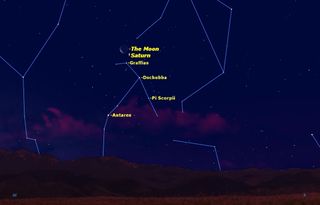See Saturn, the Moon and More Before Dawn This Weekend

There are always interesting and unusual things to see in the night sky, even if you don’t own a telescope. Saturn, the moon and several other night sky objects are currently starring in a celestial show before sunrise, but only for those early birds who know when and where to look.
A case in point is this Friday morning (Jan. 16), just before sunrise, when early risers looking southeast will be treated to the sight of a slender crescent moon and the planet Saturn.
The moon is heading between the Earth and sun as it approaches its dark New Moon phase next Wednesday (Jan. 21), so it will appear as a slender crescent lit mostly from behind. Sharp-eyed observers may see that beyond the sunlit crescent, the rest of the moon's globe is lit by the faint sunlight reflected from the Earth, which astronomers call "earthlight" or "earthshine." [Related: Brightest Planets to See in January's Night Sky]
If you watch the sky over several nights, you will notice that the objects you see move in various different ways.
Everything in the sky appears to move from east to west as the Earth rotates. The moon moves from west to east against the background stars and planets. The planets, meanwhile, move in complex ways depending on the combined movements of the planets themselves around the sun, and the movements of the moving platform from which we observe them: Earth.
At present, Saturn is moving slowly from west to east through the northern part of the constellation Scorpius. This is one of the rare groupings of stars that actually looks like its namesake, a scorpion.
The bright red giant star Antares marks the heart of the scorpion, with a long curving tail below and to the left and grasping claws above and to the right. Saturn is poised just above the uppermost claw, marked by the star Graffias.
Get the Space.com Newsletter
Breaking space news, the latest updates on rocket launches, skywatching events and more!
Anyone with a small telescope should take a look at Graffias. It is a double star, its two main components, 13.5 arc seconds apart, easily split by even the smallest telescopes. The brighter of the two components is itself a double, at 3.5 arc seconds also resolvable in most small telescopes.
Saturn is always worth a look with all but the smallest telescopes. Its famous rings are now tipped towards us, visible in any telescope able to magnify more than 25 times. At least one of its moons, Titan, should be visible in any telescope, with half a dozen more appearing in larger amateur scopes.
But even without a telescope or binoculars, the crescent Moon, Saturn, and the bright stars of Scorpius will make a fine sight for early risers.
This article was provided to SPACE.com by Simulation Curriculum, the leader in space science curriculum solutions and the makers of Starry Night and SkySafari. Follow Starry Night on Twitter @StarryNightEdu. Follow us @Spacedotcom, Facebook and Google+. Original article on Space.com.
Join our Space Forums to keep talking space on the latest missions, night sky and more! And if you have a news tip, correction or comment, let us know at: community@space.com.

Geoff Gaherty was Space.com's Night Sky columnist and in partnership with Starry Night software and a dedicated amateur astronomer who sought to share the wonders of the night sky with the world. Based in Canada, Geoff studied mathematics and physics at McGill University and earned a Ph.D. in anthropology from the University of Toronto, all while pursuing a passion for the night sky and serving as an astronomy communicator. He credited a partial solar eclipse observed in 1946 (at age 5) and his 1957 sighting of the Comet Arend-Roland as a teenager for sparking his interest in amateur astronomy. In 2008, Geoff won the Chant Medal from the Royal Astronomical Society of Canada, an award given to a Canadian amateur astronomer in recognition of their lifetime achievements. Sadly, Geoff passed away July 7, 2016 due to complications from a kidney transplant, but his legacy continues at Starry Night.
Most Popular



